 Notes: Few English towns enjoy a lovelier setting than Keswick. To the south is Derwent Water, flanked by woodland and fells, whilst to the north is the massif rising to the bare summit of Skiddaw (3,053ft). The town itself is of modest size, with 4,821 residents in 2011, and it has scarcely expanded since the 1930s thanks to planning restrictions imposed when the Lake District National Park was designated in 1951. Even before the railway arrived in 1865 Keswick was attracting tourists, but the opening of the station and the adjacent, imposing Railway Hotel made the town much more accessible. Visitors by rail would generally arrive from the Penrith direction and be enthralled by the exquisite approach to the town, heralded by the huge bulk of Blencathra (or Saddleback) dominating the northern horizon shortly before Threlkeld was reached, and followed by two miles in the wooded gorge where the train repeatedly rumbled over iron bridges crossing the River Greta with its gushing water and boulder-strewn bed. The visitor would also not fail to appreciate the charming approach to the railway from the town centre of Keswick along Station Road, built by the CK&P Railway through Fitz Park and crossing the River Greta by an elegant cast iron bridge. Notes: Few English towns enjoy a lovelier setting than Keswick. To the south is Derwent Water, flanked by woodland and fells, whilst to the north is the massif rising to the bare summit of Skiddaw (3,053ft). The town itself is of modest size, with 4,821 residents in 2011, and it has scarcely expanded since the 1930s thanks to planning restrictions imposed when the Lake District National Park was designated in 1951. Even before the railway arrived in 1865 Keswick was attracting tourists, but the opening of the station and the adjacent, imposing Railway Hotel made the town much more accessible. Visitors by rail would generally arrive from the Penrith direction and be enthralled by the exquisite approach to the town, heralded by the huge bulk of Blencathra (or Saddleback) dominating the northern horizon shortly before Threlkeld was reached, and followed by two miles in the wooded gorge where the train repeatedly rumbled over iron bridges crossing the River Greta with its gushing water and boulder-strewn bed. The visitor would also not fail to appreciate the charming approach to the railway from the town centre of Keswick along Station Road, built by the CK&P Railway through Fitz Park and crossing the River Greta by an elegant cast iron bridge.
Keswick, despite being unashamedly a tourist centre, has retained its character as a market town.
The station’s name has intermittently had ‘for Derwent Water’ added as a timetable footnote, acknowledging the important role of the station in providing access for tourists to the lake.
 Apart from the slightly larger Cockermouth, Keswick was the only intermediate town on the Penrith – Workington railway, and these two stations were substantially larger than the others on the route, contrasting with the standardised cottage buildings used elsewhere. In 1863 the contract for constructing Keswick station was awarded to Boulton & Sons (the contractors for the railway) and it was based on a plan presented by the line’s Engineer, Thomas Bouch. The station opened with the line on 2 January 1865 and from the outset was a crossing point on the otherwise single-track railway. The main building on the down (south) side of the tracks was a pleasant two-storey structure but, in Biddle’s (2003) opinion ‘a substantial but undistinguished building’ in squared random stone and ashlar trim. Bowtell (1989) describes it as ‘a workmanlike stone building … using local materials’ and ‘well gabled, ostensibly much the sort of building which a comfortably-off local Director might have built for his own occupation’. Apart from the slightly larger Cockermouth, Keswick was the only intermediate town on the Penrith – Workington railway, and these two stations were substantially larger than the others on the route, contrasting with the standardised cottage buildings used elsewhere. In 1863 the contract for constructing Keswick station was awarded to Boulton & Sons (the contractors for the railway) and it was based on a plan presented by the line’s Engineer, Thomas Bouch. The station opened with the line on 2 January 1865 and from the outset was a crossing point on the otherwise single-track railway. The main building on the down (south) side of the tracks was a pleasant two-storey structure but, in Biddle’s (2003) opinion ‘a substantial but undistinguished building’ in squared random stone and ashlar trim. Bowtell (1989) describes it as ‘a workmanlike stone building … using local materials’ and ‘well gabled, ostensibly much the sort of building which a comfortably-off local Director might have built for his own occupation’.
 The building was commodious, not only because it served a population centre but because it accommodated the CK&P offices. On the upper floor, the Boardroom was in the west wing and the office of the company Secretary was under the west gable of the central block. The Traffic Manager’s office was under the next gable and the Accountant used the east wing. On the exterior elevation the entrance was recessed between gabled projections and sheltered by a glazed portico which was added to Bouch’s design before construction was under way. Soon after the station opened, a refreshment room was added, but it operated only until 1873; Bowtell speculates that a rowdy and drunken element on days when several excursion trains were handled might have hastened its demise. A first class gentlemen’s waiting room and additional lavatory took the place of the refreshment room which itself had already surrendered space for a second class ladies’ waiting room and modified lavatories. In 1870/71 a W H Smith bookstall opened. The building was commodious, not only because it served a population centre but because it accommodated the CK&P offices. On the upper floor, the Boardroom was in the west wing and the office of the company Secretary was under the west gable of the central block. The Traffic Manager’s office was under the next gable and the Accountant used the east wing. On the exterior elevation the entrance was recessed between gabled projections and sheltered by a glazed portico which was added to Bouch’s design before construction was under way. Soon after the station opened, a refreshment room was added, but it operated only until 1873; Bowtell speculates that a rowdy and drunken element on days when several excursion trains were handled might have hastened its demise. A first class gentlemen’s waiting room and additional lavatory took the place of the refreshment room which itself had already surrendered space for a second class ladies’ waiting room and modified lavatories. In 1870/71 a W H Smith bookstall opened.
In stark contrast to the facilities on the down platform, the up platform was given only a modest waiting shelter. The water tank stood at the east end of the up platform and was reconstructed and enlarged in the early 1880s. In 1873 the CK&P decided to provide a subway between the two platforms and giving direct access to the forecourt by way of a passage with a glazed roof.

 Hard by the station building was the impressive, four-storey Keswick Hotel. Prior to the opening of the CK&P its Board was determined to have a hotel of grand proportions and they inspected hotels at Grasmere, Windermere and Ullswater to ensure that theirs would not be outclassed. Its design was drawn up by the company’s architect, John Ross. The station and hotel were connected by a glazed passageway bearing portraits of famous painters in coloured glass. The hotel was leased to a separate company headed by the railway’s Chairman. Hard by the station building was the impressive, four-storey Keswick Hotel. Prior to the opening of the CK&P its Board was determined to have a hotel of grand proportions and they inspected hotels at Grasmere, Windermere and Ullswater to ensure that theirs would not be outclassed. Its design was drawn up by the company’s architect, John Ross. The station and hotel were connected by a glazed passageway bearing portraits of famous painters in coloured glass. The hotel was leased to a separate company headed by the railway’s Chairman.
Up trains: weekdays
August 1887 |
Destination |
Down trains: weekdays |
Destination |
7.30am |
Penrith |
7.50 |
Cockermouth |
9.55am |
Penrith |
9.10am |
Workington |
11.55m |
Penrith |
10.44am |
Workington |
4.13pm |
Penrith |
2.39pm |
Workington |
6.40pm |
Penrith |
6.00pm |
Cockermouth |
- |
- |
6.45pm |
Workington |
- |
- |
8.29pm |
Workington |
Up trains: Sunday |
Destination |
Down trains: Sunday |
Destination |
10.10am |
Penrith |
7.49am |
Workington |
6.50pm |
Penrith |
6.49pm |
Workington |
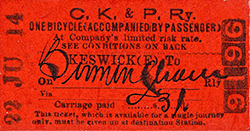 The facilities at Keswick station proved inadequate for the increasing traffic and were expanded between 1890 and 1895. Accommodation of excursion train engines and carriages was needed between their arrival towards noon and early evening departure, and through carriages resided overnight at the station to be attached to trains in the morning. The up platform was moved back and rebuilt as an island, its central portion of ample width to handle many passengers. A range of timber buildings was constructed on this platform. A loop served the north side of the island, with another beyond it used for engine run-round or stabling a train. A short bay road was constructed at the up end of the island and a bay in the western end of the main down platform. A substantial length of the down and the island platforms was given roofing which contributed greatly to the character and comfort of the station. The broad, deep canopies were carried on decorated iron columns and were of glazed ridge-and-furrow design on the down platform but hipped and slated on the island. The down platform was widened by about 7ft 6in in front of the station buildings. A narrow timber extension at its east end probably dates from this time. The facilities at Keswick station proved inadequate for the increasing traffic and were expanded between 1890 and 1895. Accommodation of excursion train engines and carriages was needed between their arrival towards noon and early evening departure, and through carriages resided overnight at the station to be attached to trains in the morning. The up platform was moved back and rebuilt as an island, its central portion of ample width to handle many passengers. A range of timber buildings was constructed on this platform. A loop served the north side of the island, with another beyond it used for engine run-round or stabling a train. A short bay road was constructed at the up end of the island and a bay in the western end of the main down platform. A substantial length of the down and the island platforms was given roofing which contributed greatly to the character and comfort of the station. The broad, deep canopies were carried on decorated iron columns and were of glazed ridge-and-furrow design on the down platform but hipped and slated on the island. The down platform was widened by about 7ft 6in in front of the station buildings. A narrow timber extension at its east end probably dates from this time.
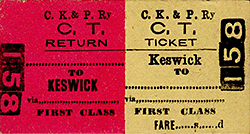 Keswick station was soon to benefit from electric lighting which was provided by the Windermere & District Electric Supply Company. The contract was agreed in late 1899. At this time very few stations in Britain were electrically lit, and Keswick remained the only station with this form of lighting on the CK&P until the intermediate stations to Penrith were converted shortly before closure. Keswick station was soon to benefit from electric lighting which was provided by the Windermere & District Electric Supply Company. The contract was agreed in late 1899. At this time very few stations in Britain were electrically lit, and Keswick remained the only station with this form of lighting on the CK&P until the intermediate stations to Penrith were converted shortly before closure.
A Saxby & Farmer signal box, in brick with a slated, hipped roof was opened in 1874 west of the station on the down side.This was known as ‘Keswick A’ (changed to ‘Keswick No.2’ in LMS days). Various workshops and stores were placed behind this box. A further, small box was opened c1889 (‘Keswick B’) towards the east end of the down platform, eventually to be replaced with an LMS box in 1932 (to be ‘Keswick No.1’).
Keswick station’s goods traffic was of a local nature and will be described later; the eastbound ironstone (or empties) and westbound coke trains passed through, calling only for the engines to take water or to enlist assistance from the rear (Bowtell, 1989). In its early form the goods yard, triangular in shape, was immediately west of the down platform. It included seven coal cells served by one siding, whilst another entered the stone-built goods warehouse, and there were two further sidings. Two more sidings of considerable length were built close to the down running line, one of them serving a loading bank and provided with a 5-ton capacity crane. The tracks from the yard joined the down running line a short distance before the up and down lines converged. A siding was also provided north of the site.
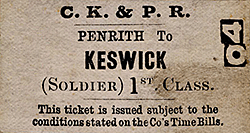 All significant changes to the yard were made before the end of the nineteenth century. A short platform was constructed beside the siding serving the coal cells to enable side-door wagons to be unloaded. At the west of the shed a matching goods office was built c1877 and the short track was cut back to accommodate it. Three cattle pens appeared on the loading bank and the track next to the down running line effectively became a bay platform line. Around 1880, a headshunt was added at the west end to enable shunting to be carried out in the yard without obstructing the through lines. A wagon weighbridge was added to the line beside the loading bank. Close to the goods warehouse a weighbridge for carts and lorries was constructed inside the road entrance in a delightful style resembling a pagoda. Before World War 1 a small oil store was added near the southern boundary of the yard. All significant changes to the yard were made before the end of the nineteenth century. A short platform was constructed beside the siding serving the coal cells to enable side-door wagons to be unloaded. At the west of the shed a matching goods office was built c1877 and the short track was cut back to accommodate it. Three cattle pens appeared on the loading bank and the track next to the down running line effectively became a bay platform line. Around 1880, a headshunt was added at the west end to enable shunting to be carried out in the yard without obstructing the through lines. A wagon weighbridge was added to the line beside the loading bank. Close to the goods warehouse a weighbridge for carts and lorries was constructed inside the road entrance in a delightful style resembling a pagoda. Before World War 1 a small oil store was added near the southern boundary of the yard.
Up trains: weekdays
June 1920 |
Destination |
Down trains: weekdays |
Destination |
7.40am |
Penrith |
8.17am |
Workington |
9.27am |
Penrith |
9.45am |
Cockermouth |
10.00am # |
Penrith |
10.42am |
Workington |
11.55am |
Penrith |
2.00pm |
Workington |
3.06pm |
Penrith |
3.41pm |
Workington |
6.31pm |
Penrith |
7.08pm |
Workington |
7.45pm |
Penrith |
9.14pm |
Workington |
No Sunday service
# Monday and Saturday from 1 June
 As at most British stations, Keswick’s goods yard handled substantial quantities of inbound coal, much of it carried by NER trains and delivered in that company’s bottom-opening wagons which could discharge their load directly into coal cells. The town gas works was a principal customer. Slate from the Honister Quarries (Buttermere Green Slate Co) was a major outbound mineral which was hauled by road to the station, originally by horse and cart and later by steam lorry. Planks produced by local sawmills, pit props, timber for Briery Bobbin Mill (rail-served between Keswick and Threlkeld) and pencils manufactured in Keswick also contributed to outbound traffic. Supplies for West Cumberland Farmers’ Trading Society arrived by rail bound for their depot. As at most British stations, Keswick’s goods yard handled substantial quantities of inbound coal, much of it carried by NER trains and delivered in that company’s bottom-opening wagons which could discharge their load directly into coal cells. The town gas works was a principal customer. Slate from the Honister Quarries (Buttermere Green Slate Co) was a major outbound mineral which was hauled by road to the station, originally by horse and cart and later by steam lorry. Planks produced by local sawmills, pit props, timber for Briery Bobbin Mill (rail-served between Keswick and Threlkeld) and pencils manufactured in Keswick also contributed to outbound traffic. Supplies for West Cumberland Farmers’ Trading Society arrived by rail bound for their depot.
In 1923 at the ‘Grouping’ the CK&P became part of the new London, Midland &Scottish Railway (LMS). In LMS ownership the passenger train service was basically six trains each way on weekdays, very much as it had been since the beginning of the century. In summer additional trains operated both on weekdays. By the late 1930s the weekday frequency had increased to eight trains. Sunday trains were few, but by the late 1920s a Sunday-only restaurant car express arrived from Glasgow (St Enoch) at 1.52pm, departing on the return journey at 6.55pm (1929 times). A Newcastle-Keswick summer Sunday train arrived from Newcastle at 1.06pm and left at 7.10pm to return to Newcastle. There was only a limited local Sunday service, for example in summer 1939 when a single train arrived from the west and returned in the evening for the benefit of half-day visitors. In wartime (1939-45) the basic service was reduced to five workings each way.
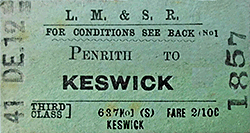 During World War II Keswick was considered a place of safety to which school children were evacuated. Newcastle Central High School girls (including the author’s mother) spent several years billeted on local families and sharing the facilities of a school in the town. Of greater railway interest was the translation of Roedean School girls and their teachers to the town; Roedean’s elevated site on the English Channel coast near Brighton was requisitioned by the army (and was subsequently passed to HMS Vernon, a naval shore establishment). The displaced Roedean community used the Keswick Hotel (and two others nearby) for accommodation and rooms in the station itself for classes. In the main station building the five upstairs rooms and a waiting room below served as classrooms. Apparently, railway passengers might blunder into this waiting room and immediately withdraw, whilst others of a bolder disposition might linger to enjoy the warmth of the fire and acquire some learning! Dances in the Greek manner were occasionally staged on the platform. Further classrooms were improvised in the hotels and even in the covered way between the station and the hotel. These details are from Bowtell (1989) where further information on the Roedean era may be enjoyed. Inevitably, the Roedean girls were provided with special beginning and end of term special trains. The final departure of Roedean was at the end of November 1945 at the beginning of a lengthy Christmas holiday. During World War II Keswick was considered a place of safety to which school children were evacuated. Newcastle Central High School girls (including the author’s mother) spent several years billeted on local families and sharing the facilities of a school in the town. Of greater railway interest was the translation of Roedean School girls and their teachers to the town; Roedean’s elevated site on the English Channel coast near Brighton was requisitioned by the army (and was subsequently passed to HMS Vernon, a naval shore establishment). The displaced Roedean community used the Keswick Hotel (and two others nearby) for accommodation and rooms in the station itself for classes. In the main station building the five upstairs rooms and a waiting room below served as classrooms. Apparently, railway passengers might blunder into this waiting room and immediately withdraw, whilst others of a bolder disposition might linger to enjoy the warmth of the fire and acquire some learning! Dances in the Greek manner were occasionally staged on the platform. Further classrooms were improvised in the hotels and even in the covered way between the station and the hotel. These details are from Bowtell (1989) where further information on the Roedean era may be enjoyed. Inevitably, the Roedean girls were provided with special beginning and end of term special trains. The final departure of Roedean was at the end of November 1945 at the beginning of a lengthy Christmas holiday.
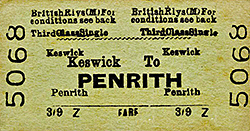 Starting long before the LMS era, but continuing during and after it, special trains ran to and from Keswick to convey participants in the Keswick Convention. The Convention was first held in 1875 and has continued for up to a week each summer (except for wartime interruptions) to the present day; it is an inter-denominational Christian gathering, drawing participants from all over the world, but large numbers from southern England. The Convention trains first ran in 1899. After World War II one return journey from London sufficed and continued until 1969 – steam hauled until 1967. Starting long before the LMS era, but continuing during and after it, special trains ran to and from Keswick to convey participants in the Keswick Convention. The Convention was first held in 1875 and has continued for up to a week each summer (except for wartime interruptions) to the present day; it is an inter-denominational Christian gathering, drawing participants from all over the world, but large numbers from southern England. The Convention trains first ran in 1899. After World War II one return journey from London sufficed and continued until 1969 – steam hauled until 1967.
The character of Keswick station was little altered during the LMS period but it is likely that the concrete lamp standards in place until closure were installed at this time; they were certainly in place by 1950, early in the BR era. Indistinct photographic evidence suggests that the standards were installed before World War II. Lamp standards in place at the eastern end of the down and island platform at closure were of an earlier metal design, perhaps to carry the original lamps installed c1900. An earlier double-hipped glazed canopy over the entrance (probably installed in the 1890s to complement the new roofing on the down platform) was replaced with a simpler one by the London, Midland & Scottish Railway (LMS) after 1923, adorned with the words ‘LMS KESWICK’ in delicate, decorative metal letters.
Up trains: weekdays
6 May to 6 Oct 1946 |
Destination |
Down trains: weekdays |
Destination |
7.53am |
Penrith |
8.18am |
Workington |
9.06am SX ¶ |
Penrith |
11.00am † |
Workington |
11.08am SO § |
Liverpool Exchange |
12.10pm ‖ |
Workington |
12.13pm ‡ |
Penrith |
1.15pm SO |
Workington |
1.02pm |
Penrith |
2.11pm # |
Workington |
3.23pm SX |
Penrith |
3.37pm SO ++ |
Cockermouth |
3.45pm SO |
Penrith |
5.45pm SX |
Workington |
4.55pm ø |
Penrith |
6.30pm MFSO |
Workington |
6.32pm |
Penrith |
7.20pm SO |
Workington |
7.40pm |
Penrith |
8.58pm |
Workington |
No Sunday service
SX Saturday excepted SO Saturday only MFSO Monday, Friday and Saturday only
‡ 6 minutes later on Monday, Friday and Saturday Ø 9 minutes later on Monday
† 8 minutes later on Monday, Friday and Saturday
‖ 7 minutes later on Tuesday, Wednesday and Thursday
~ Continues to Workington on Saturday
¶ From 8 June # 18 May to 28 September ++ 15 June to 21 September
§ 22 June to 14 September
In January 1948 at nationalisation Keswick became part of the new British Railways (BR) London Midland Region (LM); however, two years later the station entrance still possessed its ‘LMS KESWICK’ sign. The former CK&P saw the introduction of diesel multiple units in January 1955 which gradually replaced steam-hauled passenger trains.
Up trains: weekdays
11 Jun – 16 Sep 1956 |
Destination |
Down trains: weekdays |
Destination |
7.54am |
Carlisle |
7.56am |
Workington |
9.05am SO* |
Crewe |
10.53am |
Workington |
9.18am SO= |
Manchester Victoria |
12.20pm |
Workington |
9.38am # |
London Euston |
2.10pm |
Workington |
10.36am |
Carlisle ‡ |
2.34pm SO § |
Workington |
12.20pm |
Penrith |
3.49pm SX |
Workington |
1.09pm |
Carlisle |
4.15pm SO |
Workington |
2.11pm |
Penrith |
5.46pm |
Workington |
3.50pm |
Penrith |
6.58pm |
Workington † |
6.15pm |
Carlisle |
7.39pm # |
Workington |
7.27pm |
Penrith |
8.55pm~ |
Workington |
Up trains: Sunday |
Destination |
Down trains: Sunday |
Destination |
9.43am |
Carlisle |
10.06am |
Workington |
11.58am |
Carlisle |
11.57am |
Whitehaven |
4.15pm |
Carlisle |
- |
- |
Sunday services operate until 2 September 1956
SX Saturday excepted SO Saturday only § 22 June to 1 September
# 9 July to 7 Sep SX; until 15 September SO ‡ Terminates at Penrith SO
† Continues to Whitehaven SO ~ 2 minutes later on Saturday *16 July to 8 September
= 30 June to 8 September
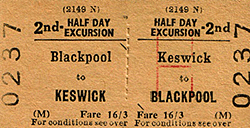 Keswick station, along with most of the others on the Workington – Penrith line, was fitted with BR(LM) maroon vitreous enamel nameboards and totem lamp tablets, probably in the late 1950s. As part of a BR policy to close goods facilities, Keswick and the other stations on the Penrith-Workington line which still possessed goods yards ceased to handle this traffic on 1 June 1964. Although the ‘Beeching Report’ of March 1963 recommended the closure to passengers of the entire Penrith – Keswick – Workington line, in January 1966 it was announced that only the section west of Keswick would close, and the following timetable would prove to be the last in which trains ran between Keswick and Workington. From 18 April 1966 Keswick became the terminus of a branch from Penrith. Keswick station, along with most of the others on the Workington – Penrith line, was fitted with BR(LM) maroon vitreous enamel nameboards and totem lamp tablets, probably in the late 1950s. As part of a BR policy to close goods facilities, Keswick and the other stations on the Penrith-Workington line which still possessed goods yards ceased to handle this traffic on 1 June 1964. Although the ‘Beeching Report’ of March 1963 recommended the closure to passengers of the entire Penrith – Keswick – Workington line, in January 1966 it was announced that only the section west of Keswick would close, and the following timetable would prove to be the last in which trains ran between Keswick and Workington. From 18 April 1966 Keswick became the terminus of a branch from Penrith.
Up trains: weekdays
14 June 1965 to 17 April 1966 |
Destination |
Down trains: weekdays |
Destination |
07.49 |
Carlisle |
07.56 |
Workington |
09.10 SO * |
Manchester Victoria / Crewe |
10.07 |
Workington |
09.33 SO ++ |
London Euston |
14.13 |
Workington |
10.07 |
Carlisle |
14.34 SO ɫ |
Workington |
12.40 |
Penrith |
17.45 |
Workington |
13.09 |
Carlisle |
18.44 |
Workington |
16.06 |
Carlisle ¶ |
18.58 # |
Workington |
18.55 |
Penrith |
20.19 |
Workington |
19.56 |
Carlisle |
- |
- |
Up trains: Sunday |
Destination |
Down trains: Sunday |
Destination |
12.00 $ |
Carlisle |
14.58 $ |
Workington |
16.15 $ |
Penrith |
16.50 $ |
Workington |
17.45 $ |
Carlisle |
19.00 $ |
Whitehaven |
18.50 = |
Newcastle |
- |
- |
20.20 $ |
Carlisle |
- |
- |
$ Until 5 September * 17 July until 21 August = 11 July until 29 August ¶ Terminates at Penrith Friday and Saturday 18 June to 4 Septemberɫ Until 21 August # SX 28 June until 27 August. Departs 18.59 SO until 28 August + + SO Until 4 September. Departs 0935 SX 28 June until 27 August
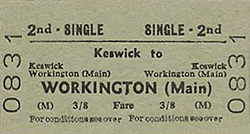 From 4 December 1967 the Keswick branch was operated as one long siding and the remaining signal boxes closed. From 1 July 1968 all five branch stations became unstaffed, no distinction being drawn between the minor intermediate stations and Keswick itself. Considering that in their later days Nottingham Victoria (closed 1967) and Birmingham Snow Hill (closed 1972) were reduced to unstaffed ‘halts’ – albeit for only two months in Nottingham’s case - the indignity suffered by Keswick station seems less significant. At Keswick the island platform was taken out of use, and only the track serving the down platform was left in place. The timetable shown below would be the final one for the station. From 4 December 1967 the Keswick branch was operated as one long siding and the remaining signal boxes closed. From 1 July 1968 all five branch stations became unstaffed, no distinction being drawn between the minor intermediate stations and Keswick itself. Considering that in their later days Nottingham Victoria (closed 1967) and Birmingham Snow Hill (closed 1972) were reduced to unstaffed ‘halts’ – albeit for only two months in Nottingham’s case - the indignity suffered by Keswick station seems less significant. At Keswick the island platform was taken out of use, and only the track serving the down platform was left in place. The timetable shown below would be the final one for the station.
Up trains: weekdays
3 May 1971 |
Destination |
07.40 |
Carlisle |
11.05 |
Penrith |
13.15 |
Penrith |
15.30 |
Penrith |
17.05 |
Penrith |
19.05 |
Carlisle |
No Sunday service.
The passenger service on the Keswick branch was withdrawn on 6 March 1972. It is generally agreed that this event marked the end of the era of significant railway closures in Great Britain.
After the station closed the island platform was demolished (by spring 1977) but the main building was acquired by the Keswick Hotel and converted into additional bedrooms. The adjoining platform and canopy have been retained with part enclosed in glass to form a lounge. The remaining building is Grade II listed.
Route map drawn by Alan Young. Tickets from Michael Stewart. Totem from Richard Furness
To see the other
stations on the Cockermouth - Penrith line click on the station name: Cockermouth 1st, Cockermouth 2nd, Embleton, Bassenthwaite Lake, Braithwaite, Briery Siding Halt, Threlkeld, Highgate Platform, Troutbeck, Penruddock & Blencow
Click here for a brief history of the Cockermouth, Keswick and Penrith Railway |




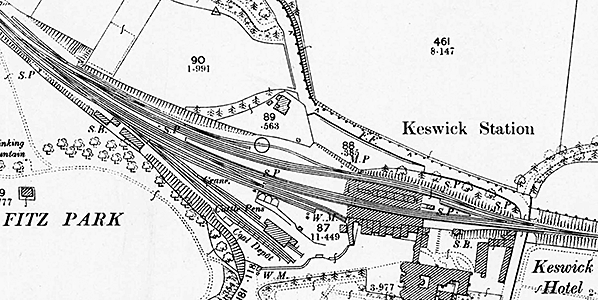



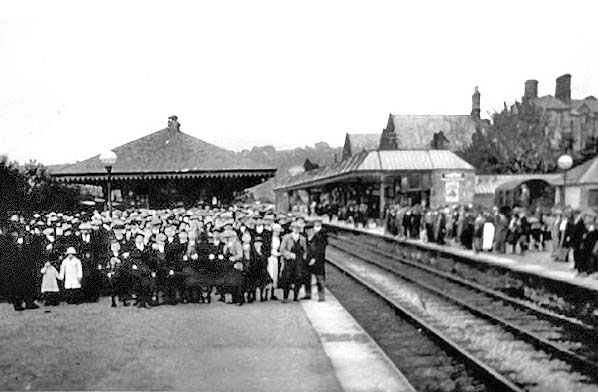
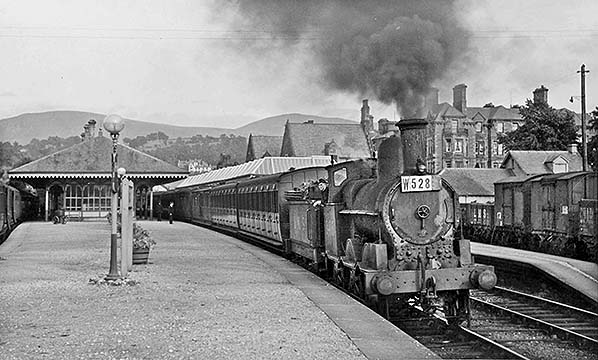

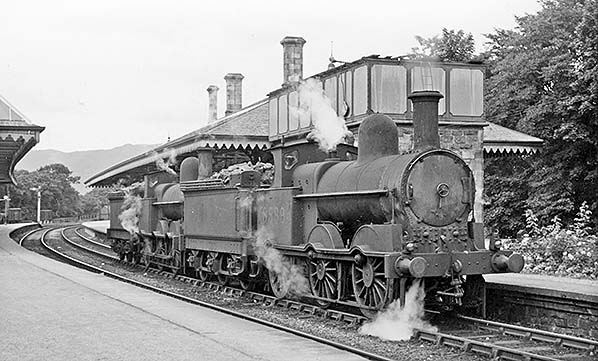
 Looking north-west on platform 1 (the down platform) of Keswick station in June 1947. The generous platform roofing is shown well in this view. Class 2F 0-6-0 Webb-designed ‘Cauliflower’ No.28547 is standing at the up (island) platform beside the elevated water tank with a passenger train to Penrith. The locomotive was built at the LNWR Crewe works in October 1900 and was withdrawn in May 1948 – the early months of British Railways – from 12D Workington shed. The leading coach is an LNWR Brake Third followed by what appears to be a Lavatory Composite.
Looking north-west on platform 1 (the down platform) of Keswick station in June 1947. The generous platform roofing is shown well in this view. Class 2F 0-6-0 Webb-designed ‘Cauliflower’ No.28547 is standing at the up (island) platform beside the elevated water tank with a passenger train to Penrith. The locomotive was built at the LNWR Crewe works in October 1900 and was withdrawn in May 1948 – the early months of British Railways – from 12D Workington shed. The leading coach is an LNWR Brake Third followed by what appears to be a Lavatory Composite.
 Notes: Few English towns enjoy a lovelier setting than Keswick. To the south is Derwent Water, flanked by woodland and fells, whilst to the north is the massif rising to the bare summit of Skiddaw (3,053ft). The town itself is of modest size, with 4,821 residents in 2011, and it has scarcely expanded since the 1930s thanks to planning restrictions imposed when the Lake District National Park was designated in 1951. Even before the railway arrived in 1865 Keswick was attracting tourists, but the opening of the station and the adjacent, imposing Railway Hotel made the town much more accessible. Visitors by rail would generally arrive from the Penrith direction and be enthralled by the exquisite approach to the town, heralded by the huge bulk of Blencathra (or Saddleback) dominating the northern horizon shortly before Threlkeld was reached, and followed by two miles in the wooded gorge where the train repeatedly rumbled over iron bridges crossing the River Greta with its gushing water and boulder-strewn bed. The visitor would also not fail to appreciate the charming approach to the railway from the town centre of Keswick along Station Road, built by the CK&P Railway through Fitz Park and crossing the River Greta by an elegant cast iron bridge.
Notes: Few English towns enjoy a lovelier setting than Keswick. To the south is Derwent Water, flanked by woodland and fells, whilst to the north is the massif rising to the bare summit of Skiddaw (3,053ft). The town itself is of modest size, with 4,821 residents in 2011, and it has scarcely expanded since the 1930s thanks to planning restrictions imposed when the Lake District National Park was designated in 1951. Even before the railway arrived in 1865 Keswick was attracting tourists, but the opening of the station and the adjacent, imposing Railway Hotel made the town much more accessible. Visitors by rail would generally arrive from the Penrith direction and be enthralled by the exquisite approach to the town, heralded by the huge bulk of Blencathra (or Saddleback) dominating the northern horizon shortly before Threlkeld was reached, and followed by two miles in the wooded gorge where the train repeatedly rumbled over iron bridges crossing the River Greta with its gushing water and boulder-strewn bed. The visitor would also not fail to appreciate the charming approach to the railway from the town centre of Keswick along Station Road, built by the CK&P Railway through Fitz Park and crossing the River Greta by an elegant cast iron bridge.  Apart from the slightly larger Cockermouth, Keswick was the only intermediate town on the Penrith – Workington railway, and these two stations were substantially larger than the others on the route, contrasting with the standardised cottage buildings used elsewhere. In 1863 the contract for constructing Keswick station was awarded to Boulton & Sons (the contractors for the railway) and it was based on a plan presented by the line’s Engineer, Thomas Bouch. The station opened with the line on 2 January 1865 and from the outset was a crossing point on the otherwise single-track railway. The main building on the down (south) side of the tracks was a pleasant two-storey structure but, in Biddle’s (2003) opinion ‘a substantial but undistinguished building’ in squared random stone and ashlar trim. Bowtell (1989) describes it as ‘a workmanlike stone building … using local materials’ and ‘well gabled, ostensibly much the sort of building which a comfortably-off local Director might have built for his own occupation’.
Apart from the slightly larger Cockermouth, Keswick was the only intermediate town on the Penrith – Workington railway, and these two stations were substantially larger than the others on the route, contrasting with the standardised cottage buildings used elsewhere. In 1863 the contract for constructing Keswick station was awarded to Boulton & Sons (the contractors for the railway) and it was based on a plan presented by the line’s Engineer, Thomas Bouch. The station opened with the line on 2 January 1865 and from the outset was a crossing point on the otherwise single-track railway. The main building on the down (south) side of the tracks was a pleasant two-storey structure but, in Biddle’s (2003) opinion ‘a substantial but undistinguished building’ in squared random stone and ashlar trim. Bowtell (1989) describes it as ‘a workmanlike stone building … using local materials’ and ‘well gabled, ostensibly much the sort of building which a comfortably-off local Director might have built for his own occupation’.  The building was commodious, not only because it served a population centre but because it accommodated the CK&P offices. On the upper floor, the Boardroom was in the west wing and the office of the company Secretary was under the west gable of the central block. The Traffic Manager’s office was under the next gable and the Accountant used the east wing. On the exterior elevation the entrance was recessed between gabled projections and sheltered by a glazed portico which was added to Bouch’s design before construction was under way. Soon after the station opened, a refreshment room was added, but it operated only until 1873; Bowtell speculates that a rowdy and drunken element on days when several excursion trains were handled might have hastened its demise. A first class gentlemen’s waiting room and additional lavatory took the place of the refreshment room which itself had already surrendered space for a second class ladies’ waiting room and modified lavatories. In 1870/71 a W H Smith bookstall opened.
The building was commodious, not only because it served a population centre but because it accommodated the CK&P offices. On the upper floor, the Boardroom was in the west wing and the office of the company Secretary was under the west gable of the central block. The Traffic Manager’s office was under the next gable and the Accountant used the east wing. On the exterior elevation the entrance was recessed between gabled projections and sheltered by a glazed portico which was added to Bouch’s design before construction was under way. Soon after the station opened, a refreshment room was added, but it operated only until 1873; Bowtell speculates that a rowdy and drunken element on days when several excursion trains were handled might have hastened its demise. A first class gentlemen’s waiting room and additional lavatory took the place of the refreshment room which itself had already surrendered space for a second class ladies’ waiting room and modified lavatories. In 1870/71 a W H Smith bookstall opened.
 Hard by the station building was the impressive, four-storey Keswick Hotel. Prior to the opening of the CK&P its Board was determined to have a hotel of grand proportions and they inspected hotels at Grasmere, Windermere and Ullswater to ensure that theirs would not be outclassed. Its design was drawn up by the company’s architect, John Ross. The station and hotel were connected by a glazed passageway bearing portraits of famous painters in coloured glass. The hotel was leased to a separate company headed by the railway’s Chairman.
Hard by the station building was the impressive, four-storey Keswick Hotel. Prior to the opening of the CK&P its Board was determined to have a hotel of grand proportions and they inspected hotels at Grasmere, Windermere and Ullswater to ensure that theirs would not be outclassed. Its design was drawn up by the company’s architect, John Ross. The station and hotel were connected by a glazed passageway bearing portraits of famous painters in coloured glass. The hotel was leased to a separate company headed by the railway’s Chairman. The facilities at Keswick station proved inadequate for the increasing traffic and were expanded between 1890 and 1895. Accommodation of excursion train engines and carriages was needed between their arrival towards noon and early evening departure, and through carriages resided overnight at the station to be attached to trains in the morning. The up platform was moved back and rebuilt as an island, its central portion of ample width to handle many passengers. A range of timber buildings was constructed on this platform. A loop served the north side of the island, with another beyond it used for engine run-round or stabling a train. A short bay road was constructed at the up end of the island and a bay in the western end of the main down platform. A substantial length of the down and the island platforms was given roofing which contributed greatly to the character and comfort of the station. The broad, deep canopies were carried on decorated iron columns and were of glazed ridge-and-furrow design on the down platform but hipped and slated on the island. The down platform was widened by about 7ft 6in in front of the station buildings. A narrow timber extension at its east end probably dates from this time.
The facilities at Keswick station proved inadequate for the increasing traffic and were expanded between 1890 and 1895. Accommodation of excursion train engines and carriages was needed between their arrival towards noon and early evening departure, and through carriages resided overnight at the station to be attached to trains in the morning. The up platform was moved back and rebuilt as an island, its central portion of ample width to handle many passengers. A range of timber buildings was constructed on this platform. A loop served the north side of the island, with another beyond it used for engine run-round or stabling a train. A short bay road was constructed at the up end of the island and a bay in the western end of the main down platform. A substantial length of the down and the island platforms was given roofing which contributed greatly to the character and comfort of the station. The broad, deep canopies were carried on decorated iron columns and were of glazed ridge-and-furrow design on the down platform but hipped and slated on the island. The down platform was widened by about 7ft 6in in front of the station buildings. A narrow timber extension at its east end probably dates from this time.  Keswick station was soon to benefit from electric lighting which was provided by the Windermere & District Electric Supply Company. The contract was agreed in late 1899. At this time very few stations in Britain were electrically lit, and Keswick remained the only station with this form of lighting on the CK&P until the intermediate stations to Penrith were converted shortly before closure.
Keswick station was soon to benefit from electric lighting which was provided by the Windermere & District Electric Supply Company. The contract was agreed in late 1899. At this time very few stations in Britain were electrically lit, and Keswick remained the only station with this form of lighting on the CK&P until the intermediate stations to Penrith were converted shortly before closure. All significant changes to the yard were made before the end of the nineteenth century. A short platform was constructed beside the siding serving the coal cells to enable side-door wagons to be unloaded. At the west of the shed a matching goods office was built c1877 and the short track was cut back to accommodate it. Three cattle pens appeared on the loading bank and the track next to the down running line effectively became a bay platform line. Around 1880, a headshunt was added at the west end to enable shunting to be carried out in the yard without obstructing the through lines. A wagon weighbridge was added to the line beside the loading bank. Close to the goods warehouse a weighbridge for carts and lorries was constructed inside the road entrance in a delightful style resembling a pagoda. Before World War 1 a small oil store was added near the southern boundary of the yard.
All significant changes to the yard were made before the end of the nineteenth century. A short platform was constructed beside the siding serving the coal cells to enable side-door wagons to be unloaded. At the west of the shed a matching goods office was built c1877 and the short track was cut back to accommodate it. Three cattle pens appeared on the loading bank and the track next to the down running line effectively became a bay platform line. Around 1880, a headshunt was added at the west end to enable shunting to be carried out in the yard without obstructing the through lines. A wagon weighbridge was added to the line beside the loading bank. Close to the goods warehouse a weighbridge for carts and lorries was constructed inside the road entrance in a delightful style resembling a pagoda. Before World War 1 a small oil store was added near the southern boundary of the yard.  As at most British stations, Keswick’s goods yard handled substantial quantities of inbound coal, much of it carried by NER trains and delivered in that company’s bottom-opening wagons which could discharge their load directly into coal cells. The town gas works was a principal customer. Slate from the Honister Quarries (Buttermere Green Slate Co) was a major outbound mineral which was hauled by road to the station, originally by horse and cart and later by steam lorry. Planks produced by local sawmills, pit props, timber for Briery Bobbin Mill (rail-served between Keswick and Threlkeld) and pencils manufactured in Keswick also contributed to outbound traffic. Supplies for West Cumberland Farmers’ Trading Society arrived by rail bound for their depot.
As at most British stations, Keswick’s goods yard handled substantial quantities of inbound coal, much of it carried by NER trains and delivered in that company’s bottom-opening wagons which could discharge their load directly into coal cells. The town gas works was a principal customer. Slate from the Honister Quarries (Buttermere Green Slate Co) was a major outbound mineral which was hauled by road to the station, originally by horse and cart and later by steam lorry. Planks produced by local sawmills, pit props, timber for Briery Bobbin Mill (rail-served between Keswick and Threlkeld) and pencils manufactured in Keswick also contributed to outbound traffic. Supplies for West Cumberland Farmers’ Trading Society arrived by rail bound for their depot. During World War II Keswick was considered a place of safety to which school children were evacuated. Newcastle Central High School girls (including the author’s mother) spent several years billeted on local families and sharing the facilities of a school in the town. Of greater railway interest was the translation of Roedean School girls and their teachers to the town; Roedean’s elevated site on the English Channel coast near Brighton was requisitioned by the army (and was subsequently passed to HMS Vernon, a naval shore establishment). The displaced Roedean community used the Keswick Hotel (and two others nearby) for accommodation and rooms in the station itself for classes. In the main station building the five upstairs rooms and a waiting room below served as classrooms. Apparently, railway passengers might blunder into this waiting room and immediately withdraw, whilst others of a bolder disposition might linger to enjoy the warmth of the fire and acquire some learning! Dances in the Greek manner were occasionally staged on the platform. Further classrooms were improvised in the hotels and even in the covered way between the station and the hotel. These details are from Bowtell (1989) where further information on the Roedean era may be enjoyed. Inevitably, the Roedean girls were provided with special beginning and end of term special trains. The final departure of Roedean was at the end of November 1945 at the beginning of a lengthy Christmas holiday.
During World War II Keswick was considered a place of safety to which school children were evacuated. Newcastle Central High School girls (including the author’s mother) spent several years billeted on local families and sharing the facilities of a school in the town. Of greater railway interest was the translation of Roedean School girls and their teachers to the town; Roedean’s elevated site on the English Channel coast near Brighton was requisitioned by the army (and was subsequently passed to HMS Vernon, a naval shore establishment). The displaced Roedean community used the Keswick Hotel (and two others nearby) for accommodation and rooms in the station itself for classes. In the main station building the five upstairs rooms and a waiting room below served as classrooms. Apparently, railway passengers might blunder into this waiting room and immediately withdraw, whilst others of a bolder disposition might linger to enjoy the warmth of the fire and acquire some learning! Dances in the Greek manner were occasionally staged on the platform. Further classrooms were improvised in the hotels and even in the covered way between the station and the hotel. These details are from Bowtell (1989) where further information on the Roedean era may be enjoyed. Inevitably, the Roedean girls were provided with special beginning and end of term special trains. The final departure of Roedean was at the end of November 1945 at the beginning of a lengthy Christmas holiday. Starting long before the LMS era, but continuing during and after it, special trains ran to and from Keswick to convey participants in the Keswick Convention. The Convention was first held in 1875 and has continued for up to a week each summer (except for wartime interruptions) to the present day; it is an inter-denominational Christian gathering, drawing participants from all over the world, but large numbers from southern England. The Convention trains first ran in 1899. After World War II one return journey from London sufficed and continued until 1969 – steam hauled until 1967.
Starting long before the LMS era, but continuing during and after it, special trains ran to and from Keswick to convey participants in the Keswick Convention. The Convention was first held in 1875 and has continued for up to a week each summer (except for wartime interruptions) to the present day; it is an inter-denominational Christian gathering, drawing participants from all over the world, but large numbers from southern England. The Convention trains first ran in 1899. After World War II one return journey from London sufficed and continued until 1969 – steam hauled until 1967.  Keswick station, along with most of the others on the Workington – Penrith line, was fitted with BR(LM) maroon vitreous enamel nameboards and totem lamp tablets, probably in the late 1950s. As part of a BR policy to close goods facilities, Keswick and the other stations on the Penrith-Workington line which still possessed goods yards ceased to handle this traffic on 1 June 1964. Although the ‘Beeching Report’ of March 1963 recommended the closure to passengers of the entire Penrith – Keswick – Workington line, in January 1966 it was announced that only the section west of Keswick would close, and the following timetable would prove to be the last in which trains ran between Keswick and Workington. From 18 April 1966 Keswick became the terminus of a branch from Penrith.
Keswick station, along with most of the others on the Workington – Penrith line, was fitted with BR(LM) maroon vitreous enamel nameboards and totem lamp tablets, probably in the late 1950s. As part of a BR policy to close goods facilities, Keswick and the other stations on the Penrith-Workington line which still possessed goods yards ceased to handle this traffic on 1 June 1964. Although the ‘Beeching Report’ of March 1963 recommended the closure to passengers of the entire Penrith – Keswick – Workington line, in January 1966 it was announced that only the section west of Keswick would close, and the following timetable would prove to be the last in which trains ran between Keswick and Workington. From 18 April 1966 Keswick became the terminus of a branch from Penrith.  From 4 December 1967 the Keswick branch was operated as one long siding and the remaining signal boxes closed. From 1 July 1968 all five branch stations became unstaffed, no distinction being drawn between the minor intermediate stations and Keswick itself. Considering that in their later days Nottingham Victoria (closed 1967) and Birmingham Snow Hill (closed 1972) were reduced to unstaffed ‘halts’ – albeit for only two months in Nottingham’s case - the indignity suffered by Keswick station seems less significant. At Keswick the island platform was taken out of use, and only the track serving the down platform was left in place. The timetable shown below would be the final one for the station.
From 4 December 1967 the Keswick branch was operated as one long siding and the remaining signal boxes closed. From 1 July 1968 all five branch stations became unstaffed, no distinction being drawn between the minor intermediate stations and Keswick itself. Considering that in their later days Nottingham Victoria (closed 1967) and Birmingham Snow Hill (closed 1972) were reduced to unstaffed ‘halts’ – albeit for only two months in Nottingham’s case - the indignity suffered by Keswick station seems less significant. At Keswick the island platform was taken out of use, and only the track serving the down platform was left in place. The timetable shown below would be the final one for the station.


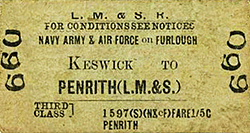

 Home Page
Home Page